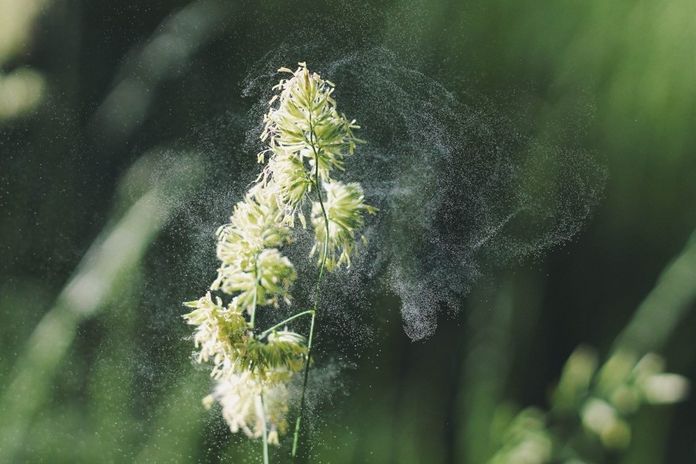
More than 20% of Switzerland's population suffers from pollen allergies, and this number is steadily increasing. The impact of climate change on pollen and its effect on our health were explored by Marloes Eeftens from Swiss TPH during her opening lecture for the "Advanced Training in Public Health Zurich*". This monthly series invites experts to examine various public health topics. Read on to learn more about her key findings.
Why does Pollen Fly?
"Pollen is not only incredibly beautiful but also highly annoying for many allergy sufferers. It causes irritation and discomfort," began Marloes Eeftens. Pollen, which are the male gametes of plants, range in size from 10-150 μm, slightly larger than fine dust. For pollen to travel from one plant to another, it must either rely on insects or be carried by the wind. It is this pollen, spread by the wind, that particularly concerns Marloes Eeftens, as it significantly affects our health.
When Does Pollen Fly?
The pollen season consists of different phases. “For instance, trees blossom in the early part of the year, grasses in summer (like now), and herbs bloom last. Allergic individuals who react to multiple types of pollen often suffer from allergies throughout the year”, explained Eeftens. Additionally, there are periods of high pollen concentration and lulls when there is little or no pollen in the air.
Climate Change and Pollen
Switzerland has been monitoring pollen levels for about 50 years, but comprehensive nationwide data covering the entire year is only available for the past 31 years. The following trends have been observed during recent decades:
- The pollen season starts earlier, especially for highly allergenic species such as hazel, oak, grasses, and stinging nettle. This has significant health implications.
- The duration of the pollen season has increased, with measurements indicating an extension of up to 37 days.
- The intensity of the pollen season has risen dramatically, resulting in a higher volume of pollen being produced and disseminated by trees, grasses, and herbs.
These trends are not unique to Switzerland; they are observed throughout Europe and are attributed to climate change. Consequently, allergy sufferers experience longer and more severe symptoms. Moreover, highly allergenic plants like ragweed are spreading across Europe due to climate change and seed dispersal.
Frequency of Pollen Allergies in Switzerland
The Aha! Allergy Centre Switzerland estimates that at least 20% of Switzerland's population suffers from pollen allergies, commonly known as allergic rhinitis or hay fever. This trend of increasing pollen allergies is not limited to Western countries but occurs worldwide.
Lower Pollen Levels in the Mountains
Studies conducted by the EPOCHAL project - Effects of Pollen on Cardiorespiratory Health and Allergic Symptoms - at the Swiss Tropical and Public Health Institute (Swiss TPH) have demonstrated that pollen levels are lower in mountainous regions. The project utilizes spatial and temporal exposure modeling to examine the impact of pollen on mortality, hospitalization, and pre-clinical symptoms.
Marloes Eeftens explained, "First, we gather all the pollen data from the MeteoSchweiz pollen monitoring network, which includes observed pollen concentrations. We then combine this data with satellite data, such as green areas, land use, and species distribution (to identify areas where allergenic trees are prevalent, for example)." This modeling approach enables the identification of when and where the Swiss population experiences the highest pollen exposure. Typically, exposure is lower in mountainous areas compared to urban environments.
The Influence of Pollen on Health
Over 400 individuals participated in the Effects of Pollen on Cardiorespiratory Health and Allergies (EPOCHAL) study, in which they were repeatedly asked about health effects during the pollen season. The results of this panel study are consistent with findings from other research. Pollen can affect blood pressure, quality of life, and sleep. Long-term consequences include sleep disorders and obstructive sleep apnea caused by impaired sleep and chronic nasal congestion.
Severe health effects
Furthermore, acute exposure to high pollen concentrations has been linked to severe health effects, such as increased hospital admissions due to asthma attacks, higher mortality rates from COPD and pneumonia, and an uptick in strokes and heart attacks. Consequently, the overall mortality rate also rises.
The Growing Importance of Public Health Measures
Until now, the focus has mainly been on individual-level interventions, including immunotherapy and medication. However, as the proportion of the population affected by pollen allergies continues to rise, public health measures at the population level are becoming increasingly vital. These measures aim to reduce overall pollen exposure. The most crucial step is to halt or at least mitigate climate change.
Additionally, it is worth considering the choice of plants in different areas. For example, instead of planting allergenic trees like birch in cities, less allergenic alternatives can be chosen. When introducing new trees, these aspects should be taken into account. Moreover, efforts to eradicate highly allergenic and invasive plants like ragweed are necessary. Implementing indoor air filtration systems in public buildings could also help mitigate pollen exposure.
Personal Summary by Marloes Eeftens:
- Climate change is altering pollen release, resulting in earlier, longer, and more intense pollen seasons.
- Allergic diseases are on the rise.
- While few studies have explored health effects beyond itching and sneezing, it is likely that pollen allergies have broader consequences.
- Interventions should address both environmental factors and individual well-being.
Personal Recommendations by Marloes Eeftens for Affected Individuals:
- If you have a strong reaction to birch or hazel, it is advisable to avoid planting these trees in your garden.
- Stay informed by checking the pollen forecasts from MeteoSchweiz, which provide valuable insights into upcoming pollen levels.
- Desensitization therapy is a viable option for severe symptoms, but it requires planning in advance and is not an instant solution.
- Otherwise, individuals must endure symptoms by staying indoors, keeping necessary medications on hand, and hoping for rainfall.
- More tips and tricks for managing pollen allergies can be found at Aha! Allergy Centre Switzerland

Prof. Dr. Marloes Eeftens, the Head of Research for "Sensoring and Environmental Epidemiology" at the Swiss Tropical and Public Health Institute (Swiss TPH), delivered the lecture. To view the lecture slides, click here.
*The "Advanced Training in Public Health Zurich" is a collaborative initiative between the Institute of Epidemiology, Biostatistics, and Prevention at the University of Zurich and the Cantonal Medical Service, Health Directorate of the Canton of Zurich. The complete programme can be found here.